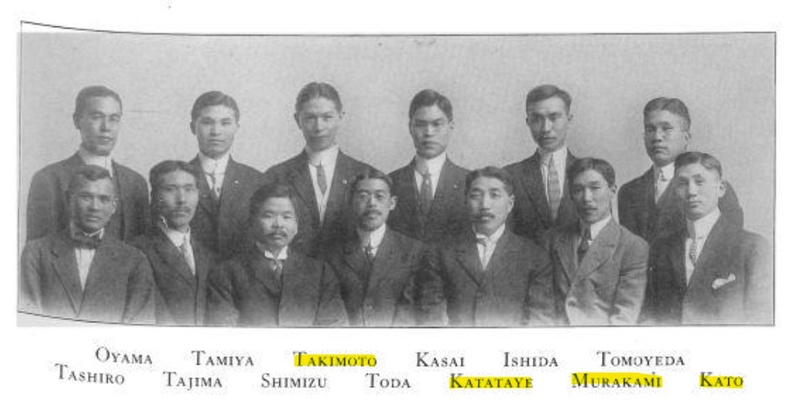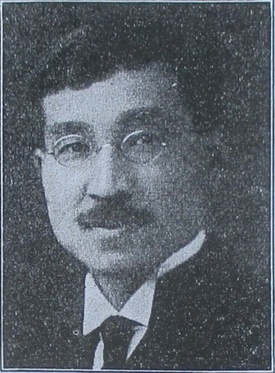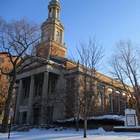According to Misaki Shimazu, there were four stages of activity among the Japanese Christians in Chicago: the Fujita era, the Baptist days, the Confusion period, and the Separation and Independence era.1 The first period, the Fujita era, was from July 1899 to April 1903, when Toshiro Fujita was the Japanese Consul in Chicago. A few Japanese met at Consul Fujita’s home twice a month to study Christianity. Consul Fujita was a Christian2 and he managed all of the correspondence of these Japanese Christians.
Shimazu named the second period the Baptist days after the founding of the Japanese Baptist Mission, around December 1904, by Aijiro Tashiro, Kamori Shimose, Komataro Katataye and Suejiro Miyamori. Tashiro was a thirty-three-year-old single butler3 and Shimose and Miyamori were students of the Divinity School at the University of Chicago, the former from 1903 to 19054 and the latter from 1902 to 1904.5 Because the mission was the project they took on while at the Divinity School, their activities ended shortly after they graduated. But Tashiro and Shimose brought more than $50 in donations to the mission fund, by putting up a tall sign that read “Japanese Baptist Mission” outside the kindergarten at the Immanuel Baptist church at 2320 Michigan Ave, which helped publicize the Mission.6
The third stage, or the Confusion period, is thus named since it was the period when Shimazu and various Japanese Christians engaged in mission work without a formal affiliation to any one organization. These Japanese Christians were also pioneers in Chicago's Japanese Christian history.
Naotaro Otsuka entered the Graduate Divinity School at the University of Chicago in 18997 and received his Bachelor of Divinity degree in 1905.8 He regularly led the Baptist group’s Sunday meetings.
Otsuka returned to Japan in early 1906, leaving his Baptist mission work to Komataro Katataye who came to Chicago in April 1905. Katataye made his residence at the Japanese Mission Home, a lodging facility for Japanese immigrants that he founded, located at 2938 Prairie Avenue, and invited other Japanese students and their families to stay there.9 Katataye entered the University of Chicago Graduate Divinity School in 1907.10 In October 1908, Katataye moved the Mission Home to 3338 Vernon Avenue11 and then to 3147 Vernon Avenue in 1910. He lived there with his wife, three children, (two of whom were born in Illinois,12 and University of Chicago student Junichiro Tamiya.13
Meanwhile, the Japanese Gospel Society was established in early 1907, which began the fourth stage, the separation and independence era. Supporters asked two Japanese divinity students, Akizane Kato and Kunisaburo Nakagawa, to step up to become preachers for the Society. Kato, from Toyama, Japan, entered the Divinity School at the University of Chicago in 1902,14 after graduating from medical school in Tokyo. Nakagawa had ten years of experience preaching in Japan before coming to the U.S.15 He registered as a student for two months at the Moody Bible Institute in July 1902, but switched to the Graduate Divinity School at the University of Chicago in 1903.16 From 1904 to 1906 he was registered at the Northwestern University Garrett Biblical Institute as well.17 However, both Kato and Nakagawa declined to lead the Japanese Gospel Society. As a result, the aforementioned Misaki Shimazu accepted the offer as the group's preacher.18
Shimazu was born in Yonezawa, Japan in 1877, graduated from Anglo-Japanese College, Methodist school in Tokyo in 1886,19 and came to the U.S. in 1904. Having worked as a Christian missionary for a year on the West Coast,20 he entered the Divinity School at the University of Chicago in 1905.21 He was registered as an unclassified divinity student until 1908.22 In July 1907, however, Shimazu left Chicago to matriculate at the Union Theological Seminary of New York.23 Fortunately, the Japanese Gospel Society was then able to appoint Magojiro Furuya to succeed Shimazu.
Furuya arrived in the U.S. in 1900 and initially lived in Los Angeles. In 1905, he entered the Chicago Theological Seminary.24 Eventually, Furuya changed the name of the Japanese Gospel Society to the Chicago Japanese Young Men’s Christian Association. This was the beginning of the Japanese YMCA (JYMCA). Although they used the term “YMCA,” the group had no relationship with the Central YMCA of Chicago. In August 1907, Furuya rented a house at 3036 Groveland Avenue and turned it into a JYMCA dormitory to board Japanese who wished to live in Chicago.25
A year later, in May 1908, Shimazu graduated from the Union Theological Seminary of New York with the degree of Bachelor of Divinity26 and returned to Chicago. Furuya graduated from the Chicago Theological Seminary with a Bachelor of Divinity degree the same year, then returned to California where his brother lived, leaving the Japanese YMCA in the care of Shimazu.27
Katataye, who established the Japanese Mission Home, received his Bachelor of Divinity degree from the University of Chicago in 190928 and returned to Japan in July 1911. After Katataye left Chicago, the name of the lodging facility was changed to the Japanese Christian Association. The word “association” was used to show that they were free from any particular denomination.29
By 1911, the Japanese Christian community was divided in two: the Japanese Christian Association (JCA), an offshoot of the Japanese Mission Home that Katataye had started, and the JYMCA, that Shimazu had taken over. Both were listed in the Social Service Directory of Chicago of 1915. According to the Directory, the JCA undertook educational, charity and philanthropic work for Japanese immigrants and secured employment for its members free of charge.30 The JYMCA was also listed as an employment office, which offered free job services for young men. The difference between the two groups was that the JYMCA was categorized as a residence, with a capacity of 35, whereas the JCA was not, although it actually did have lodging capabilities.31
Rumors among Japanese Chicagoans were quite common. In a newspaper article, a Japanese writer named Jitsuzo Harada wrote that the JCA was commonly known as a safe harbor for skeptics from the West32 and for stowaways and illegal immigrants from New York.33 In short, “sketchy” Japanese approached the JCA, but the “respectable” gathered at the JYMCA.34
Leadership at the JCA went through many transitions within a short period of time35: from Tamezo Takimoto36 to Peter T. Yanase37; and then from Shigeshi Tani38 to Jitsuzo Harada,39 in rapid succession.Takimoto came to the US in 1907 and studied political economy at the University of Chicago from 1909 to 1912. He must have been Christian, as he attended the opening ceremony of the Salvation Army in San Francisco in August 1919.40 Yanase had been a student at Moody Bible Institute from October 1912 to August 1913 and was a faithful, industrious and obedient Christian who had preached in Japan before coming to the U.S.41
The location of the JCA changed frequently, from 3338 Vernon Avenue to 3580 Lake Street42 and then to 936 E 42nd Place.43 Despite the organizational turbulence, people welcomed the JCA to Chicago, and some even published a song in Japanese about it in Nichibei Shuho in 1913.44 One of JCA’s biggest supporters was Shigeshi Tani, who was involved with the JCA the longest, from 1914 to around 1930. Tani was born in Kochi, Japan in June 1880 and came to California to study to be a missionary. He was registered as a student at the Moody Bible Institute from October 1910 to May 1912. Tani’s records from the Institute describe him as “courteous, gracious, splendid specimen of his race, poor work in bible, very strong among his people.”45 This mostly glowing evaluation foreshadowed his eventual leadership of the JCA. Tani felt a sense of rivalry toward Shimazu46; he held lecture meetings at the JCA, published newsletters, ran a chain of restaurants, and opened a Japanese language school there.
The last location of the JCA was a three story building at 4352 Cottage Grove, which had a restaurant and a stationary store on the first floor. The restaurant served Japanese meals for just 30-35 cents, and the grocery store sold stationary and souvenirs imported from Japan. The second and third floors housed lodging rooms, each of which had three beds. The charge for these rooms was less than $10.00 per week, including breakfast and dinner.47 In the 1920s, the area around 4352 Cottage Grove was absorbed into what is known as the Black Belt.48 As if he were pushed out by a wave of migration, Tani disappeared from Chicago around 1930.
Notes:
1. Shimazu, Misaki, “Shikago Nihonjin Dendo Jigyo Enkaku Ryaku-shi,” Nichibei Shuho, January 25, 1913.
2. Chicago Tribune, February 12, 1922.
3. 1900 census.
4. Annual Register, University of Chicago 1903-1904, 1904-1905.
5. Annual Register, 1902-1903, 1903-1904.
6. Shimadzu, Nichibei Shuho, January 25, 1913.
7. Annual Register, 1899-1900.
8. Annual Register, 1905-1906.
9. 1910 census.
10. Annual Register, 1907-1908.
11. Nichibei Shuho, October 3, 1908.
12. 1910 census.
13. Annual Register, 1910-1911.
14. Annual Register, 1902-1903.
15. Moody Bible Institute Student Record.
16. Annual Register, 1903-1904.
17. Bulletin of Northwestern University Annual Catalogue, 1904-1905, 1905-1906.
18. Shimazu, Nichibei Shuho, January 25, 1913.
19. Union Theological Seminary Catalogue, 1907-1908.
20. The Japanese Student, January 1919.
21. Annual Register, 1905-1906.
22. Annual Register, 1907-1908.
23. The Japanese Student, January 1919.
24. The Chicago Seminary Quarterly, Vol V, No 4, 1906.
25. Nichibei Shuho, May 16, 1914.
26. The Japanese Student, January 1919.
27. Chicago Theological Seminary Register II, No 4, Yearbook 1909. WWI Registration, 1910 Census.
28. Annual Register, 1910-1911.
29. Nichibei Shuho, November 9, 1912.
30. The Social Service Directory of Chicago 1915, page 60 & 81.
31. Ibid.
32. Nichibei Shuho, January 8, 1916.
33. Ito, Kazuo Shikago ni Moyu, page 156.
34. Nichibei Shuho, January 8, 1916.
35. Nichibei Shuho, January 1, 1914 and May 16, 1914.
36. Yoshida, Toyohichi, “Nihonjin Kirisuto Kyokai no Hattatsu ni Tsuite” Shikago Gakuen, No. 8, 1917.
37. Manager, Japanese Christian Association (3850 Lake Park Ave) 1914 Chicago City Directory.
38. Secretary, Japanese Christian Association (3850 Lake Park Ave) 1915 Chicago City Directory.
39. Nichibei Shuho, January 1, 1914 & May 16, 1914.
40. Sakaguchi, The Journal of Shibusawa Studies, October 1993, page 20.
41. Moody Bible Institute Student record.
42. 1914 Chicago City directory.
43. 1917 Chicago City Directory.
44. Nichibei Shuho, April 19, 1913.
45. Moody Bible Institute student record.
46. Nichibei Jiho, March 5, 1927.
47. Ito, Shikago Nikkei Hyakunen-shi, page 192.
48. Drake, St Clair and Cayton, Horace R, Black Metropolis: A Study of Negro Life in a Northern City, page 63.
© 2021 Takako Day








